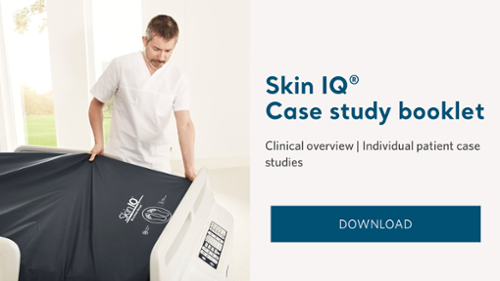
Although high or prolonged pressure is often viewed as the most significant extrinsic factor in pressure injury development, there is a growing appreciation of the effects of microclimate in pressure injury formation and healing.1 Controlling microclimate is a key factor for patients at risk of maceration and skin breakdown.2
What is microclimate?
The term microclimate is used to describe two parameters3:
- Humidity or skin surface moisture at the interface between the body and the support surface
- Temperature at the skin surface or the soft tissues
Why is Microclimate Management important in pressure injury prevention and management?
Elevated temperature and humidity can affect the structure and function of the skin4 and reduce the tolerance of the skin and tissues to the damaging effects of pressure, shear and friction5. It has been suggested that an elevated skin temperature increases the metabolic demand of local tissues, increases the tissues requirement for oxygen and increases the susceptibility of the tissues, to the ischaemic effects of pressure and shear5 whilst also weakening the stratum Corneum.6
Excessive moisture against the skin causes maceration which reduces stiffness, and connective tissue strength and increases the susceptibility to shear forces.7 Friction at the skin interface with the support surface is also increased promoting adhesion to the sheet or bedclothes and increasing the risk of mechanical damage and superficial pressure injuries.
Managing Microclimate with Skin IQ

Any surface that is in contact with the skin has the potential to affect the microclimate. The overall effect is dependent on the nature of the support surface and the cover.
There are numerous ways to normalise the local skin microclimate, the simplest being to reposition the patient. However, this is not always possible and many patients may require additional interventions. The International Pressure Ulcer Prevention and Management Guidelines1 discuss how managing microclimate can provide an environment conducive to injury prevention and tissue repair. As such the guidelines recommend the need for additional features such as the ability to control moisture and temperature when selecting a support surface.
An effective addition to the support surface is the Skin IQ Microclimate Manager, a powered coverlet designed to fit over an existing active or reactive mattress which adds microclimate control, without compromising the pressure redistribution properties of the support surface.
The Skin IQ MCM applies a unique negative airflow to draw temperature away from the skin and mattress interface. This single patient use mattress coverlet is water resistant, and vapour permeable.
Following a number of bench tests and field trials, Skin IQ MCM has proven beneficial in normalising microclimate, reducing odour and promoting an environment conducive to healing.8,9,10,11
To learn more about the clinical benefits of Skin IQ and to see the results from case studies, please download the case study document below:
References
1. National Pressure Ulcer Advisory Panel, European Pressure Ulcer Advisory Panel and Pan Pacific Pressure Injury Alliance. Prevention and Treatment of Pressure Ulcers: Clinical Practice Guideline. Emily Haesler (Ed). Cambridge Media: Perth, Australia; 2014
2. International review International review. Pressure ulcer prevention: pressure, shear, friction and microclimate in context. A consensus document. London: Wounds International, 2010.
3. National Pressure Ulcer Advisory Panel (NPUAP).Support Surface Standards Initiative. NPUAP, 2007.Available at: http://www.npuap.org/NPUAP_S3I_TD.pdf
4. Kottner J, Black, J, Call, E, Gefen, A, Santamaria N (2018) Microclimate: a critical review in the context of pressure ulcer prevention
5. Clark M, Black J (2011) Skin IQTM Microclimate Made Easy. Wounds International 2011; 2(2). Available from http://www.woundsinternational.com
6. Clark M, Romanelli M, Reger S et al (2010). Microclimate in context. In: Baharestani M, Black J, Carville K et al (2010). International Review. Pressure ulcer prevention: pressure, shear, friction and microclimate in context. Wounds International.
7. Reger S, Ranganathan VK, Sahgai V (2007). Support surface interface pressure: an analysis of the literature. Ostomy Wound Management 53(10): 50-58.
8. Reger S, Ranganathan V, McNulty A (2014). Use of a powered coverlet for moisture removal, skin temperature reduction, odour and bacteria control. J Wound Ostomy Continence Nursing, 41(1)35-39.
9. Clark M, Lahmann N (2017). Clinical evaluation of the Skin IQ Microclimate Manager and case reports. Wounds International. 2011 (suppl.):1-4. At: http://www.woundsinternational.com/media/issues/533/files/content 10235.pdf accessed August 2017.
10. Kohr R (2011). Simple solutions for low air loss needs: evaluating a new surface. Poster presentation, 30th CAET National Conference, Montreal, Quebec, May 26th-29th.
11. Collier M, Potts C, Shaw E (2014). Use of a coverlet system for the management of skin microclimate. British Journal of Nursing (Tissue Viability Supplement 23(15):S28-35.
